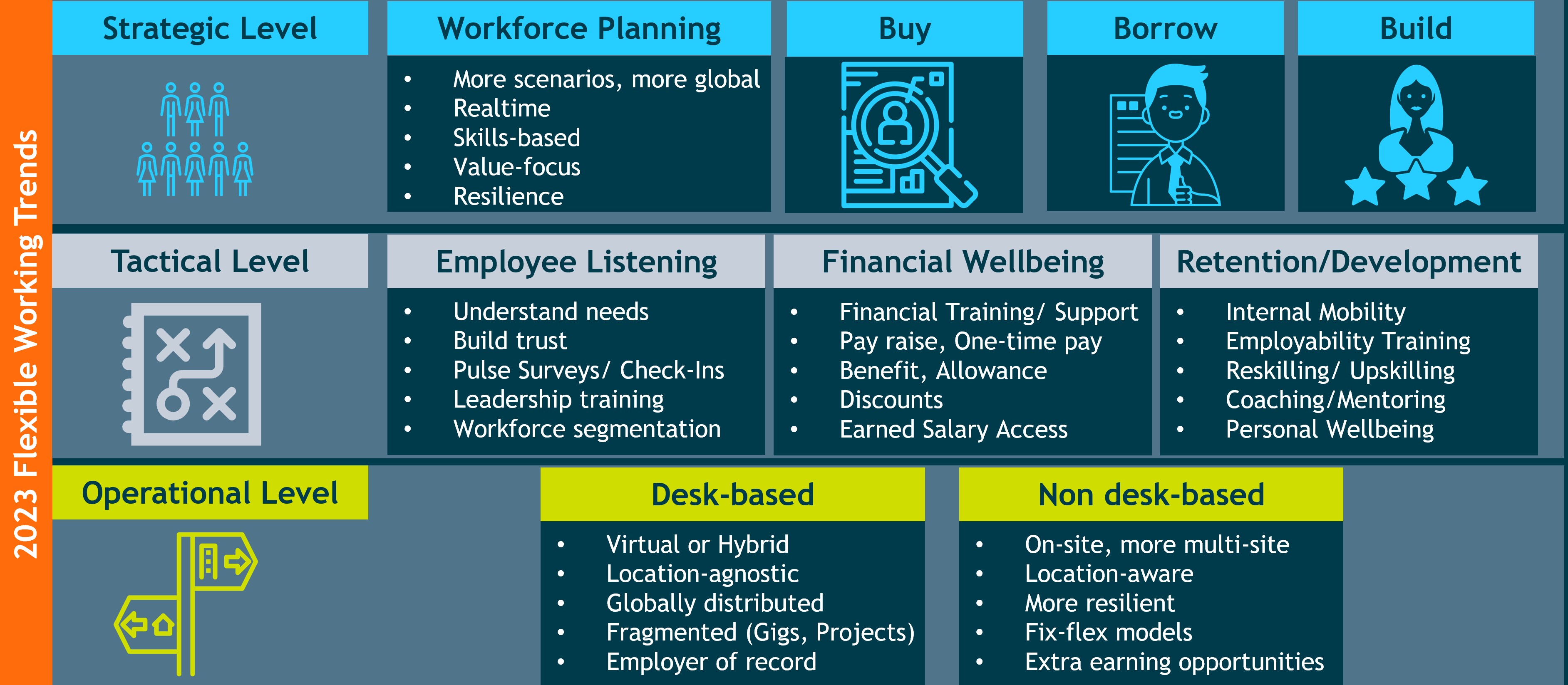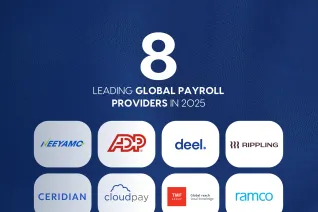Flexible Working Trends 2023 – An EMEA Perspective

In 2020, the COVID-19 pandemic disrupted modern working and has affected where, when, and how people work. As the COVID-fallout subsides, another set of disruptions keeps the corporate world, business leaders, HR teams, and employees in EMEA on their toes: the armed conflict in Europe, resultant energy and cost-of-living crisis, rising inflation, a skills availability crisis, and ongoing climate concerns. To thrive in this business environment requires increasing levels of flexibility and agility strategically, tactically, and operationally.
In this blog, Sven Elbert, Senior Analyst HCM and Talent at Fosway Group, Europe’s #1 HR Industry Analyst, looks at the latest trends in flexible working and how organizations are looking to evolve their approach in 2023 and beyond.

2023 Flexible Working Trends © Fosway Group.
Where are we with flexible working?
Nearly three-quarters of EMEA headquartered organizations have completely or significantly changed their approach to where, when, and how people work over the last two years – only 8% reported making no change. The first months of the COVID-19 pandemic left no doubt where work had to happen – at home if it was desk-based, and socially distanced when it was not affected by lockdowns. Organizations flexed around the when and how and evolved from a hard lockdown mode to a flexible virtual or hybrid mode. Without the pandemic, much of this would not have been possible, as there was a lot of resistance to allowing significant numbers of employees to work from home. Organizations see the shift to flexible and hybrid working arrangements as a positive one for three reasons:
- Employee Retention & Attraction
- Business Productivity
- Employee Engagement
The drivers behind flexible working are not necessarily business cost or sustainability, although they might play a role, too. Remarkably,65% of HR professionals see flexible working driving higher productivity– a belief supported by many studies. Flexible working is here to stay, and many organizations are looking to expand their approach to it.
Flexible Working Trends 2023 – operational level
When looking at flexible working trends on an operational level, we need to differentiate between desk-based and non-desk-based work. Desk-based work is increasingly being virtualized and people can work from anywhere as long as there is an internet connection. Hence, desk-based work is becoming even more location-agnostic and globally distributed. This type of work continues to fragment into projects, gigs, or individual tasks. In healthcare, for example, many magnetic resonance scans done locally in Europe are digitally transmitted for analysis to Asia, with the results transferred back and communicated to the patient by local hospital staff. This example is bad news for highly skilled European workers: their higher education kept them on the job, and they are feeling increased pressure to develop new skills that will ensure their employability in the future.

Figure 1: Flexible Working Trends 2023 – Operational Level © Fosway Group.
Another trend to accelerate further into 2023 is around ‘Employer of Record’ solutions. These solutions allow EMEA organizations to employ individual staff in countries where they otherwise have no legal entity or operation. This helps organizations entering new markets to hire local expert talent.
Non-desk-based work, on the other hand, will always be location-aware and on-site. Here, organizations with multiple sites are looking to flex work across these sites. Due to the cost-of-living crisis, more employees are looking for extra earning opportunities, which helps accelerate multi-site flexing. During the last year, many European countries have each seen their specific version of skills shortages, whether truck drivers or luggage handlers. Hence, organizations are now thinking about how to increase resilience and better plan for seasonal spikes. But one thing remains clear for the operational workforce – too much flexibility is also not desirable for many employees. Parents who need to pick up their children from school or kindergarten don’t like 100% flexible working models but rather prefer a fix-flex model, where certain elements are fixed, and the employer flexes around their preferences. This capability is crucial for employers, as other local employers might offer this benefit and pay more.
Flexible Working Trends 2023 – strategic level
Due to economic uncertainties, it is no surprise that organizations are prioritising strategic workforce planning as they move into 2023. In addition, limited skills availability has amplified strategic workforce planning as a lever for HR success. HR teams are now preparing for a few scenarios, including a mild, medium, and a deeper recession. The critical question is how to flex workforce supply under these scenarios. And while organizations used to run these monster spreadsheet processes, they now need to be able to execute strategic workforce planning in real-time based on actual data. And even more importantly, they need to be able to look at individual skills, not just job titles. This is vital to flexing workforce supply across the diverse global channels in an organization’s “buy – borrow– build”-paradigm. Many organizations – for example, in German Mittelstand – also have to become more resilient and less vulnerable to a single point of failure in their supply chains and supplier- or customer-ecosystems.

Figure 2: Flexible Working Trends 2023 – Strategic Level © Fosway Group.
Flexible Working Trends 2023 – tactical level
On a tactical level, organizations are focusing on three things: employee listening, financial well-being, and retention & development. Of course, the elephant in the room is the cost-of-living crisis, which is driving financial well-being high up the corporate agenda. But only organizations that clearly understand the specific issues in the different segments of their workforce will be able to react quickly and efficiently. To support employees, many organizations are looking to launch financial training/support initiatives, look at pay rises (usually ideally below inflation rates) or one-time payments, discounts (e.g. in the canteen), or provide earned salary access solutions to help ease the troubles. However, about 20% of organizations are already forced to make compromises to their employer value proposition by slowing or stopping the competitiveness of salaries, benefits, and perks or their approach to personal well-being. And since this is a significant opportunity for their competitors to go after their best talent, they are looking to put retention and development programs in place to ensure the talent drain will not be too significant. Rehiring people can be an expensive and lengthy process; something organizations will want to avoid in 2023.

Figure 3: Flexible Working Trends 2023 – Tactical Level © Fosway Group.
About Fosway
Fosway Group is Europe's #1 HR Industry Analyst focused on Next Gen HR, Talent and Learning. Founded in 1996, we are known for our unique European research, our independence and our integrity. And just like the Roman road we draw our name from, you'll find that we're unusually direct. We don't have a vested interest in your supplier or consulting choices. So, whether you're looking for independent research, specific advice, or a critical friend to cut through the market hype, we can tell you what you need to know to succeed.
Talk to us today on +44 (0) 207 917 1870 or via info@fosway.com, or visit us at www.fosway.com
Latest Resources
Stay informed with latest updates
If you're curious and have a thirst for knowledge pertaining to the HR, payroll, and EOR universe, don't miss out on subscribing to our resources.















